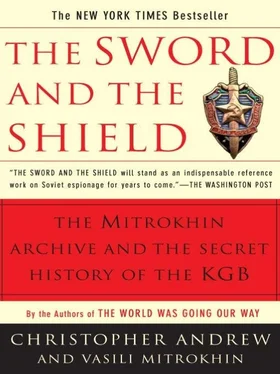LATE IN 1998, the Swiss authorities began removing a radio cache in woods near Berne identified by Mitrokhin, 52which exploded when fired on by a water-cannon. A spokesman for the Federal Prosecutor’s office issued a warning that if any further caches were discovered, they should not be touched: “Anyone who tried to move the [KGB] container would have been killed.” 53In Belgium, radio sets were safely removed from three other KGB caches (codenamed ALPHA-1, ALPHA-2 and ALPHA-5). 54Given the dangerous condition of an unpredictable number of the KGB’s Cold War radio and arms caches, the SVR now has no excuse for failing to reveal their exact locations to the governments of all the countries in which they have been hidden.
In addition to using Line F officers in KGB residencies to run or supervise its operations, the Thirteenth Department and its successor also had a small group of illegals, trained in sabotage techniques and other “special actions,” who moved around the world from one sabotage target or “wet job” to another. 55The most active was Igor Vitalyevich Voytetsky (codenamed PAUL), who began training as an illegal in 1956 at the age of twenty-three. Voytetsky’s father, Gleb Pavlovich Shlyandin, had committed suicide at the height of the Great Terror in 1937. His mother, Sofya Davidovna Rudnitskaya, who worked as a music teacher, had remarried Vitali Panteleymonovich Voytetsky, a film director in the Gorky Film Studio. According to his legend, Voytetesky was “Emil Evraert,” the son of a Belgian father, Ernst Evraert, and a German mother, Hedwig Marta Althammer. Ernst Evraert had lived in Russia since 1933; “Hedwig Althammer” did not exist. However, a KGB agent, codenamed RAG, who worked for the commune of Bellecour in the Belgian province of Hainault, made a bogus entry in the commune records which purported to show that PAUL and his fictitious mother had lived there from October 15, 1943 to December 14, 1944. On the strength of this entry and forged identity documents provided by the FCD Illegals Directorate S, PAUL obtained a Belgian passport in the name of Emil Evraert on November 8, 1962, then crossed the Channel to England.
On January 30, 1963, in Dover Register Office, Voytetsky married another KGB illegal, Yulia Ivanovna Gorankova (codenamed VIRGINIA), who was then able to apply for genuine Belgian identity documents to replace her forged West German passport. Assisted by Gorankova, Voytetsky embarked on a full-time career as an illegal working for the Thirteenth Department. 56His first assignment was in Northern Ireland, where he selected sites for airborne and maritime landings by DRGs. He then reconnoitred landing sites in Scotland, where he also identified suitable bases for wartime “resistance movements” by Scottish Communists, prepared large dead-drops for sabotage equipment, identified vulnerable sections of oil pipelines and other targets and selected agents for carrying out sabotage operations. Over the next decade, before becoming an illegal trainer in 1975, Voytetsky carried out similar assignments in Austria, Belgium, Canada, France, Greece, Hong Kong, Israel, Italy, Spain, Turkey and the United States—probably the first ever saboteur’s world tour. 57
THOUGH THE FCD greatly expanded its sabotage capability during the 1960s, it became increasingly confused about the traditional speciality of its “special actions” department—the liquidation of “enemies of the people” abroad. The targets of most of the assassination plots during the 1960s and 1970s recorded in the KGB files seen by Mitrokhin concerned the KGB’s own defectors, all of whom were sentenced to death for treason during secret trials held in absentia. Despite the risks of further bad publicity in the West if they were hunted down, the Centre was determined not to allow the belief to spread within KGB ranks that traitors could escape their just deserts:
The KGB must intensify the spirit of hatred towards the enemy and traitors. Significant harm is done by the comforting theory that losses are inevitable in wars between intelligence services. At meetings and in reports, betrayals are sometimes called compromises. Compromises, by which is meant operational failures, are usually provoked by skillful dangles by the enemy. Equating these two concepts usually leads to the moral justification of traitors, and creates an image of them as victims of the intelligence skills of the enemy. Defectors do not go unpunished. Their punishment is described in such proverbs as: “The traitor Judas is hated everywhere.” “A mercenary dog deserves a stake through the heart” and “A traitor is his own murderer.” 58
Deep concern in the Centre at the damage done by Anatoli Golitsyn’s defection from the Helsinki residency in December 1961 strengthened its determination to deter future defectors. Unaware of the confusion caused inside the CIA by Golitsyn’s increasingly extravagant conspiracy theories, the KGB regarded his defection as a serious setback. 59His case prompted a major review by the Centre of its procedures for liquidating traitors outside the Soviet Union. In November 1962 Semichastny, who had succeeded Shelepin as KGB chairman, a year earlier, approved a plan for “special actions” against a group of “particularly dangerous traitors,” jointly drawn up by the heads of the First and Second Chief Directorates, Aleksandr Mikhailovich Sakharovsky and Oleg Mikhailovich Gribanov:
As these traitors, who have given important state secrets to the opponent and caused great political damage to the USSR, have been sentenced to death in their absence, this sentence will be carried out abroad.
The oldest name on the death list was that of the former GRU cipher clerk Igor Gouzenko, who had defected in 1945. The remainder were more recent KGB defectors: Anatoli Golitsyn, Pyotr Deryabin, Yuri Rastvorov, Vladimir and Evdokia Petrov, Reino Hayhanen, Nikolai Khokhlov and Bogdan Stashinsky. 60The plan approved by Semichastny instructed the Thirteenth Department to train assassins to carry out the death sentences on the traitors. The FCD Counter-Intelligence Department (later Directorate K) was to track them down in their foreign refuges, in collaboration with the Second Chief Directorate, which would maintain surveillance of the traitors’ relatives inside the Soviet Union, monitor their correspondence and carry out periodic searches of their homes. 61In Golitsyn’s case it was hoped that he would emerge from hiding to give evidence to a Congressional committee and provide an opportunity for a KGB assassin. 62
In 1964 reports appeared in the American press that the former illegal Reino Hayhanen, who had betrayed “Willie” Fisher (alias “Rudolf Abel”), had been killed in a road accident. FCD personnel were informed that the “accident” had been arranged by the Thirteenth Department. Though KGB had, in reality, no hand in Hayhanen’s death, most foreign intelligence officers were taken in by their chief’s disinformation. 63The truth, which the Centre could not bring itself to admit even to its own officers, was that it rarely succeeded in tracking down any of those on the list of “particularly dangerous traitors” and that, even when it did so, it could not devise methods of assassinating them which did not carry unacceptable risks.
During the 1960s, the names of several further defectors were added to the list of “particularly dangerous traitors” to be liquidated abroad. The first was Yuri Nosenko, a KGB officer who had made secret contact with the CIA in June 1962 while serving on the Soviet disarmament delegation in Geneva and who defected to the United States in January 1964. 64Unlike any of the other defectors on the 1962 list of “particularly dangerous traitors,” Nosenko was imprisoned, though not executed. By a terrible irony, however, his jailers were not the KGB but the CIA. Golitsyn had claimed that the KGB would send a series of bogus defectors in an attempt to discredit him. Nosenko, he insisted, was one of them. Tragically, Nosenko’s debriefers, like Angleton, the chief of the counterintelligence staff, believed Golitsyn. They paid too much attention to some of the apparent gaps and discrepancies in Nosenko’s story—notably the confusion over his rank. They also wrongly concluded that some of his information was too good to be true—particularly his accurate report in the wake of Kennedy’s assassination that Oswald’s file in the Centre showed that the KGB considered him mentally unstable and had declined to use him as an agent, despite his period in the Soviet Union. And they foolishly regarded as suspicious rather than rational Nosenko’s lack of support for Golitsyn’s conspiracy theories. Pete Bagley, chief of the counterintelligence branch of the CIA’s Soviet Division, complained, “[Nosenko] made everything sound less sinister than Golitsyn. To me, Golitsyn’s version was simply superior.” For four years and eight months Nosenko was imprisoned by the CIA in miserable conditions, without reading material or human contact, while his interrogators insisted he admit that he was a KGB plant. Few cases in American intelligence history have been so appallingly mishandled. 65
Читать дальше











